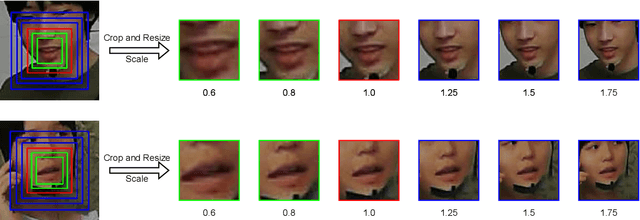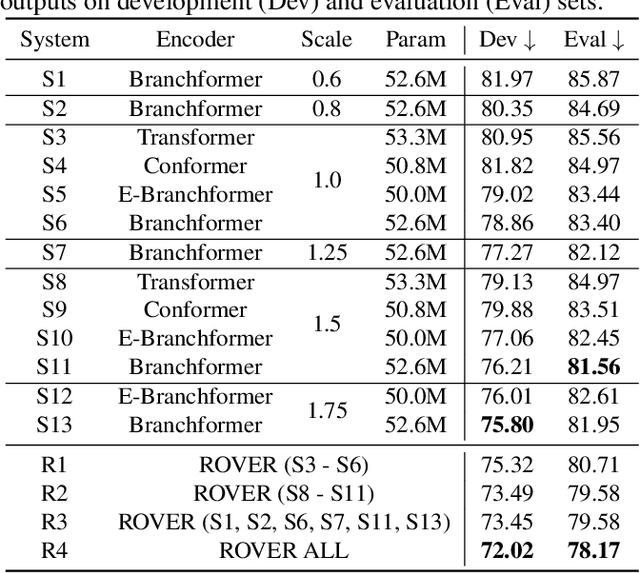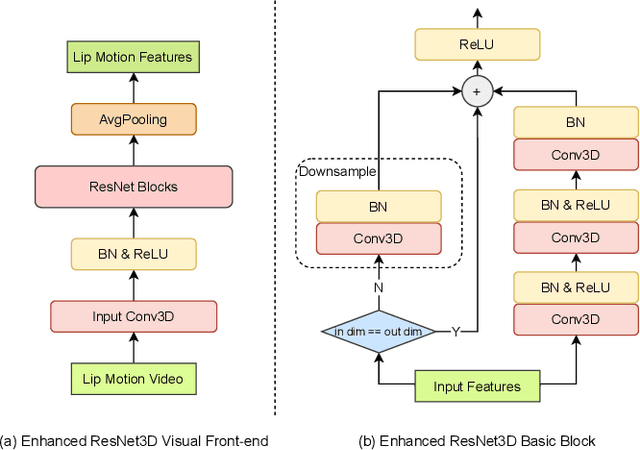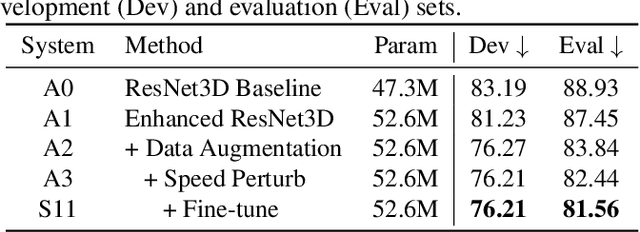Huan Zhou
PromptMID: Modal Invariant Descriptors Based on Diffusion and Vision Foundation Models for Optical-SAR Image Matching
Feb 25, 2025Abstract:The ideal goal of image matching is to achieve stable and efficient performance in unseen domains. However, many existing learning-based optical-SAR image matching methods, despite their effectiveness in specific scenarios, exhibit limited generalization and struggle to adapt to practical applications. Repeatedly training or fine-tuning matching models to address domain differences is not only not elegant enough but also introduces additional computational overhead and data production costs. In recent years, general foundation models have shown great potential for enhancing generalization. However, the disparity in visual domains between natural and remote sensing images poses challenges for their direct application. Therefore, effectively leveraging foundation models to improve the generalization of optical-SAR image matching remains challenge. To address the above challenges, we propose PromptMID, a novel approach that constructs modality-invariant descriptors using text prompts based on land use classification as priors information for optical and SAR image matching. PromptMID extracts multi-scale modality-invariant features by leveraging pre-trained diffusion models and visual foundation models (VFMs), while specially designed feature aggregation modules effectively fuse features across different granularities. Extensive experiments on optical-SAR image datasets from four diverse regions demonstrate that PromptMID outperforms state-of-the-art matching methods, achieving superior results in both seen and unseen domains and exhibiting strong cross-domain generalization capabilities. The source code will be made publicly available https://github.com/HanNieWHU/PromptMID.
CAMEL: Cross-Attention Enhanced Mixture-of-Experts and Language Bias for Code-Switching Speech Recognition
Dec 17, 2024



Abstract:Code-switching automatic speech recognition (ASR) aims to transcribe speech that contains two or more languages accurately. To better capture language-specific speech representations and address language confusion in code-switching ASR, the mixture-of-experts (MoE) architecture and an additional language diarization (LD) decoder are commonly employed. However, most researches remain stagnant in simple operations like weighted summation or concatenation to fuse language-specific speech representations, leaving significant opportunities to explore the enhancement of integrating language bias information. In this paper, we introduce CAMEL, a cross-attention-based MoE and language bias approach for code-switching ASR. Specifically, after each MoE layer, we fuse language-specific speech representations with cross-attention, leveraging its strong contextual modeling abilities. Additionally, we design a source attention-based mechanism to incorporate the language information from the LD decoder output into text embeddings. Experimental results demonstrate that our approach achieves state-of-the-art performance on the SEAME, ASRU200, and ASRU700+LibriSpeech460 Mandarin-English code-switching ASR datasets.
XCB: an effective contextual biasing approach to bias cross-lingual phrases in speech recognition
Aug 20, 2024


Abstract:Contextualized ASR models have been demonstrated to effectively improve the recognition accuracy of uncommon phrases when a predefined phrase list is available. However, these models often struggle with bilingual settings, which are prevalent in code-switching speech recognition. In this study, we make the initial attempt to address this challenge by introducing a Cross-lingual Contextual Biasing(XCB) module. Specifically, we augment a pre-trained ASR model for the dominant language by integrating an auxiliary language biasing module and a supplementary language-specific loss, aimed at enhancing the recognition of phrases in the secondary language. Experimental results conducted on our in-house code-switching dataset have validated the efficacy of our approach, demonstrating significant improvements in the recognition of biasing phrases in the secondary language, even without any additional inference overhead. Additionally, our proposed system exhibits both efficiency and generalization when is applied by the unseen ASRU-2019 test set.
MMGER: Multi-modal and Multi-granularity Generative Error Correction with LLM for Joint Accent and Speech Recognition
May 06, 2024



Abstract:Despite notable advancements in automatic speech recognition (ASR), performance tends to degrade when faced with adverse conditions. Generative error correction (GER) leverages the exceptional text comprehension capabilities of large language models (LLM), delivering impressive performance in ASR error correction, where N-best hypotheses provide valuable information for transcription prediction. However, GER encounters challenges such as fixed N-best hypotheses, insufficient utilization of acoustic information, and limited specificity to multi-accent scenarios. In this paper, we explore the application of GER in multi-accent scenarios. Accents represent deviations from standard pronunciation norms, and the multi-task learning framework for simultaneous ASR and accent recognition (AR) has effectively addressed the multi-accent scenarios, making it a prominent solution. In this work, we propose a unified ASR-AR GER model, named MMGER, leveraging multi-modal correction, and multi-granularity correction. Multi-task ASR-AR learning is employed to provide dynamic 1-best hypotheses and accent embeddings. Multi-modal correction accomplishes fine-grained frame-level correction by force-aligning the acoustic features of speech with the corresponding character-level 1-best hypothesis sequence. Multi-granularity correction supplements the global linguistic information by incorporating regular 1-best hypotheses atop fine-grained multi-modal correction to achieve coarse-grained utterance-level correction. MMGER effectively mitigates the limitations of GER and tailors LLM-based ASR error correction for the multi-accent scenarios. Experiments conducted on the multi-accent Mandarin KeSpeech dataset demonstrate the efficacy of MMGER, achieving a 26.72% relative improvement in AR accuracy and a 27.55% relative reduction in ASR character error rate, compared to a well-established standard baseline.
Enhancing Lip Reading with Multi-Scale Video and Multi-Encoder
Apr 08, 2024



Abstract:Automatic lip-reading (ALR) aims to automatically transcribe spoken content from a speaker's silent lip motion captured in video. Current mainstream lip-reading approaches only use a single visual encoder to model input videos of a single scale. In this paper, we propose to enhance lipreading by incorporating multi-scale video data and multi-encoder. Specifically, we first propose a novel multi-scale lip extraction algorithm based on the size of the speaker's face and an enhanced ResNet3D visual front-end (VFE) to extract lip features at different scales. For the multi-encoder, in addition to the mainstream Transformer and Conformer, we also incorporate the recently proposed Branchformer and EBranchformer as visual encoders. In the experiments, we explore the influence of different video data scales and encoders on ALR system performance and fuse the texts transcribed by all ALR systems using recognizer output voting error reduction (ROVER). Finally, our proposed approach placed second in the ICME 2024 ChatCLR Challenge Task 2, with a 21.52% reduction in character error rate (CER) compared to the official baseline on the evaluation set.
Exploiting Low-level Representations for Ultra-Fast Road Segmentation
Feb 06, 2024



Abstract:Achieving real-time and accuracy on embedded platforms has always been the pursuit of road segmentation methods. To this end, they have proposed many lightweight networks. However, they ignore the fact that roads are "stuff" (background or environmental elements) rather than "things" (specific identifiable objects), which inspires us to explore the feasibility of representing roads with low-level instead of high-level features. Surprisingly, we find that the primary stage of mainstream network models is sufficient to represent most pixels of the road for segmentation. Motivated by this, we propose a Low-level Feature Dominated Road Segmentation network (LFD-RoadSeg). Specifically, LFD-RoadSeg employs a bilateral structure. The spatial detail branch is firstly designed to extract low-level feature representation for the road by the first stage of ResNet-18. To suppress texture-less regions mistaken as the road in the low-level feature, the context semantic branch is then designed to extract the context feature in a fast manner. To this end, in the second branch, we asymmetrically downsample the input image and design an aggregation module to achieve comparable receptive fields to the third stage of ResNet-18 but with less time consumption. Finally, to segment the road from the low-level feature, a selective fusion module is proposed to calculate pixel-wise attention between the low-level representation and context feature, and suppress the non-road low-level response by this attention. On KITTI-Road, LFD-RoadSeg achieves a maximum F1-measure (MaxF) of 95.21% and an average precision of 93.71%, while reaching 238 FPS on a single TITAN Xp and 54 FPS on a Jetson TX2, all with a compact model size of just 936k parameters. The source code is available at https://github.com/zhouhuan-hust/LFD-RoadSeg.
BA-MoE: Boundary-Aware Mixture-of-Experts Adapter for Code-Switching Speech Recognition
Oct 08, 2023Abstract:Mixture-of-experts based models, which use language experts to extract language-specific representations effectively, have been well applied in code-switching automatic speech recognition. However, there is still substantial space to improve as similar pronunciation across languages may result in ineffective multi-language modeling and inaccurate language boundary estimation. To eliminate these drawbacks, we propose a cross-layer language adapter and a boundary-aware training method, namely Boundary-Aware Mixture-of-Experts (BA-MoE). Specifically, we introduce language-specific adapters to separate language-specific representations and a unified gating layer to fuse representations within each encoder layer. Second, we compute language adaptation loss of the mean output of each language-specific adapter to improve the adapter module's language-specific representation learning. Besides, we utilize a boundary-aware predictor to learn boundary representations for dealing with language boundary confusion. Our approach achieves significant performance improvement, reducing the mixture error rate by 16.55\% compared to the baseline on the ASRU 2019 Mandarin-English code-switching challenge dataset.
X-SepFormer: End-to-end Speaker Extraction Network with Explicit Optimization on Speaker Confusion
Mar 09, 2023Abstract:Target speech extraction (TSE) systems are designed to extract target speech from a multi-talker mixture. The popular training objective for most prior TSE networks is to enhance reconstruction performance of extracted speech waveform. However, it has been reported that a TSE system delivers high reconstruction performance may still suffer low-quality experience problems in practice. One such experience problem is wrong speaker extraction (called speaker confusion, SC), which leads to strong negative experience and hampers effective conversations. To mitigate the imperative SC issue, we reformulate the training objective and propose two novel loss schemes that explore the metric of reconstruction improvement performance defined at small chunk-level and leverage the metric associated distribution information. Both loss schemes aim to encourage a TSE network to pay attention to those SC chunks based on the said distribution information. On this basis, we present X-SepFormer, an end-to-end TSE model with proposed loss schemes and a backbone of SepFormer. Experimental results on the benchmark WSJ0-2mix dataset validate the effectiveness of our proposals, showing consistent improvements on SC errors (by 14.8% relative). Moreover, with SI-SDRi of 19.4 dB and PESQ of 3.81, our best system significantly outperforms the current SOTA systems and offers the top TSE results reported till date on the WSJ0-2mix.
Improving Target Speaker Extraction with Sparse LDA-transformed Speaker Embeddings
Jan 16, 2023Abstract:As a practical alternative of speech separation, target speaker extraction (TSE) aims to extract the speech from the desired speaker using additional speaker cue extracted from the speaker. Its main challenge lies in how to properly extract and leverage the speaker cue to benefit the extracted speech quality. The cue extraction method adopted in majority existing TSE studies is to directly utilize discriminative speaker embedding, which is extracted from the pre-trained models for speaker verification. Although the high speaker discriminability is a most desirable property for speaker verification task, we argue that it may be too sophisticated for TSE. In this study, we propose that a simplified speaker cue with clear class separability might be preferred for TSE. To verify our proposal, we introduce several forms of speaker cues, including naive speaker embedding (such as, x-vector and xi-vector) and new speaker embeddings produced from sparse LDA-transform. Corresponding TSE models are built by integrating these speaker cues with SepFormer (one SOTA speech separation model). Performances of these TSE models are examined on the benchmark WSJ0-2mix dataset. Experimental results validate the effectiveness and generalizability of our proposal, showing up to 9.9% relative improvement in SI-SDRi. Moreover, with SI-SDRi of 19.4 dB and PESQ of 3.78, our best TSE system significantly outperforms the current SOTA systems and offers the top TSE results reported till date on the WSJ0-2mix.
CGI-Stereo: Accurate and Real-Time Stereo Matching via Context and Geometry Interaction
Jan 07, 2023



Abstract:In this paper, we propose CGI-Stereo, a novel neural network architecture that can concurrently achieve real-time performance, state-of-the-art accuracy, and strong generalization ability. The core of our CGI-Stereo is a Context and Geometry Fusion (CGF) block which adaptively fuses context and geometry information for more accurate and efficient cost aggregation and meanwhile provides feedback to feature learning to guide more effective contextual feature extraction. The proposed CGF can be easily embedded into many existing stereo matching networks, such as PSMNet, GwcNet and ACVNet. The resulting networks are improved in accuracy by a large margin. Specially, the model which integrates our CGF with ACVNet could rank 1st on the KITTI 2012 leaderboard among all the published methods. We further propose an informative and concise cost volume, named Attention Feature Volume (AFV), which exploits a correlation volume as attention weights to filter a feature volume. Based on CGF and AFV, the proposed CGI-Stereo outperforms all other published real-time methods on KITTI benchmarks and shows better generalization ability than other real-time methods. The code is available at https://github.com/gangweiX/CGI-Stereo.
 Add to Chrome
Add to Chrome Add to Firefox
Add to Firefox Add to Edge
Add to Edge